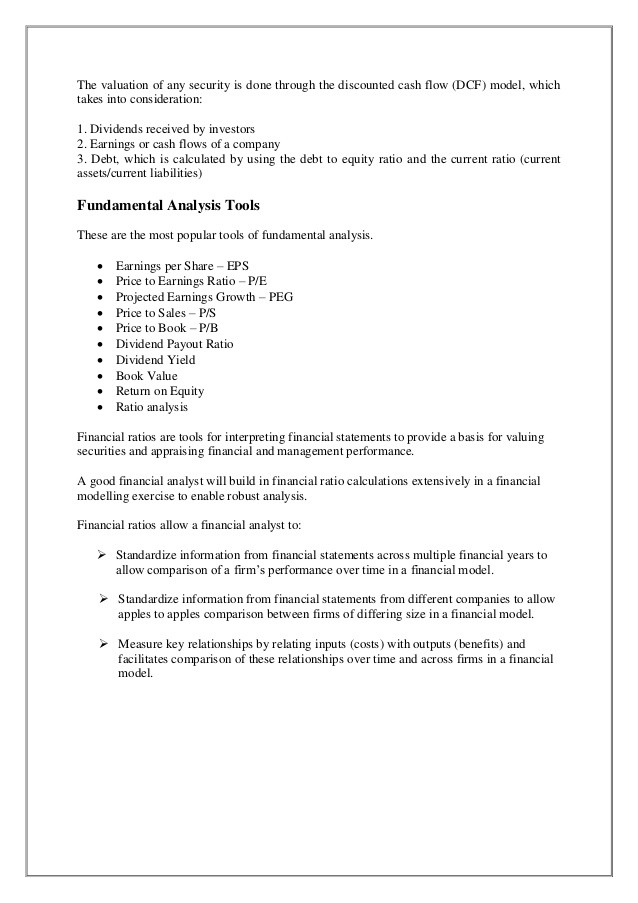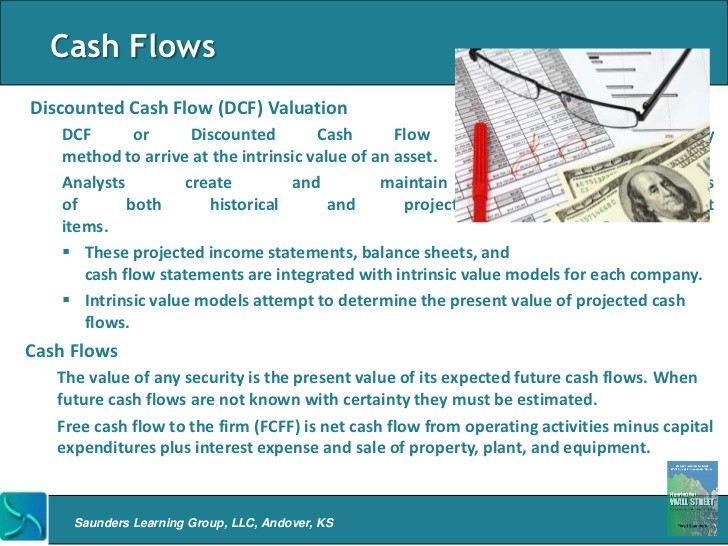Retail Investo Valuing Stocks Using the Discounted Cash Flow (DCF) Model Investor Education
Post on: 2 Май, 2015 No Comment

The Basic Issue
Before even thinking about valuing stocks using discounted cash flows, first see how this method fits into the possible investing strategies discussed on the Big Picture Strategy page. This methodology for valuing projects is very powerful. It has three basic inputs; the cash flow dollars, the timing of those cash flows and the rate of return demanded. But there are more than a few problems when trying to use it for valuing stocks.
- The model presumes receipt of, and benefit from, all the cash flows by the investor himself. That will be true of the stock’s purchase and sale price and its dividends. But what about companies which pay no (or small) dividends? Then the eventual sale price becomes the dominant factor in the stock’s valuation. When the current value is derived from the future resale price, any assumptions about the valuation at the later date self-justify the current value. If the current value depends on discounted cash flows, then that future sale price will also depend on discounted cash flows. So any analysis would have to go far into the future, until the discount rate makes those cash flows immaterial. That analysis is never done, with any valuation methods using cash flows.
Discounted Dividends
An old valuation model using discounted cash flows is the Discounted Dividend model (the Gordon Growth formula). The formula is derived mathematically by summing the present value (discounted value) of each future year’s dividend. But is it really a discounted cash flow model? No. It misses the point.
The idea behind calculating the Net Present Value of cash flows requires an active estimate of each future cash flow — its size and timing. In contrast, the discounted dividend models simply assumes the cash flows to be equal (adjusted for growth) forever. At best, an allowance is made for one change (possibly two) in the future. What is being accomplished by the calculation is not ‘discounting cash flows’. The model effectively ‘capitalizes’ the yield. There is a qualitative difference between the two systems.
E.g. you find a perpetual preferred share’s value by ‘capitalizing’ its income — by dividing the dividend $$ by your required return. E.g. you capitalize real estate’s profits by dividing the operating cash flow by your required Cap Rate. E.g. you find a stock’s value by capitalizing its earnings — dividing earnings by your required earnings yield (using P/E metrics).
The Gordon equation finds the security’s value necessary to make the sum of the dividend yield plus growth equal the investor’s required rate of return. The equation can be derived without any discounting at all. It ‘capitalizes’ the dividends.
Capitalizing Cash Flow or Price-to-Cashflow
There is another valuation system that may be labeled as ‘discounted cash flows’, but it is really only a ‘capitalizing’ model. Instead of capitalizing dividends or earnings, it capitalizes some defined measure of ‘cash flow’. Cash flow is divided by some appropriate required return (equivalent to the earning yield, so let’s call it ‘cash yield’) to determine a security’s value.
This is what has happened when you hear the ‘experts’ saying It is trading at just 4 times cash flow. This multiple of Price to CashFlow (P/C) is equivalent to the P/E multiple. But there are many problems.
- No matter what measure of cash flow you use, the flow varies widely year by year. Yet when you capitalize a particular year’s cash flow you are presuming it is ‘normal’ and will continue forever (with presumed growth).
Most of us are familiar with P/E multiples. We know the historical averages and extremes. We know what values are appropriate for different industries or growth rates. But none of that is true for P/C. Should we consider the P/C in comparison to the P/E, or in comparison between stocks? Is ‘half-the-PE’ appropriate? What are we supposed to DO with the number?

Discounted Cash Flow
The true discounted cash flow model is necessarily made of two parts. For the first period of years the company’s cash payments and receipts are modeled year by year, line item by line item. The yearly net cash is discounted back to the present. After that a steady sustainable rate of growth is presumed for the long run. The stock’s presumed value at that time, using simple P/E metrics usually, is also discounted back to the present.
One model is presented by Aswath Damodaran on this spreadsheet. His book detailing the method is published online from this directory.
- For each year of the foreseeable future the expected net cash increase/decrease is calculated. It reflects the left column in the diagram above.
- Net Income (Warning! other models start from other points and will therefore have other adjusting entries.)
- less increases to working capital
- plus new financing received net of debt principal repaid
- less purchases of fixed assets for growth and replacement
- plus (to reverse out) depreciation and amortization
Damodaran’s CashFlow (unlike most all other’s) is predicted to be less than the accountants’ earnings (Net Income) because he includes the costs of growth investments. —
- Increases to Working Capital are necessary for growth, even if the growth is due only to inflation. It is most common to see the current quarter/year’s change in current assets used as if it is a ‘normalized’ value. In fact there are large swings from quarter to quarter, year to year, even though over the longer term the funding level is stable for a given level of sales.
Don’t include in your analysis of working capital: cash, the current portion of long-term-debt and bank debt. It is cash you are trying to measure and the debt is handled separately.
Remember to add the higher interest payments that result from additional debt in the year-by-year cash flow modeled.
Companies also grow by paying for Goodwill and Intangible assets. You could argue that these expenses should be included in the cost of new fixed assets. But in reality most often these are paid for by issuing additional share capital of the company. There is no cash flow. Since the model does not reflect any changes to the percentage ownership of a share, it seem appropriate to ignore both these sides of the transaction.














